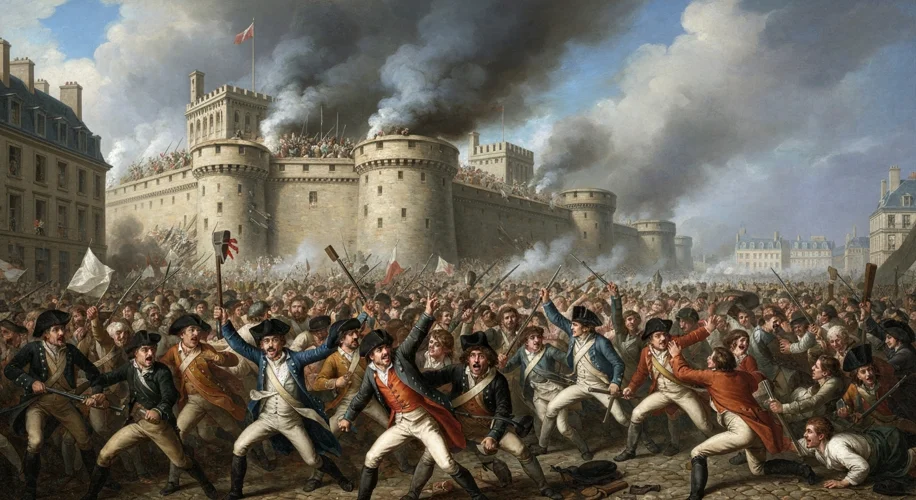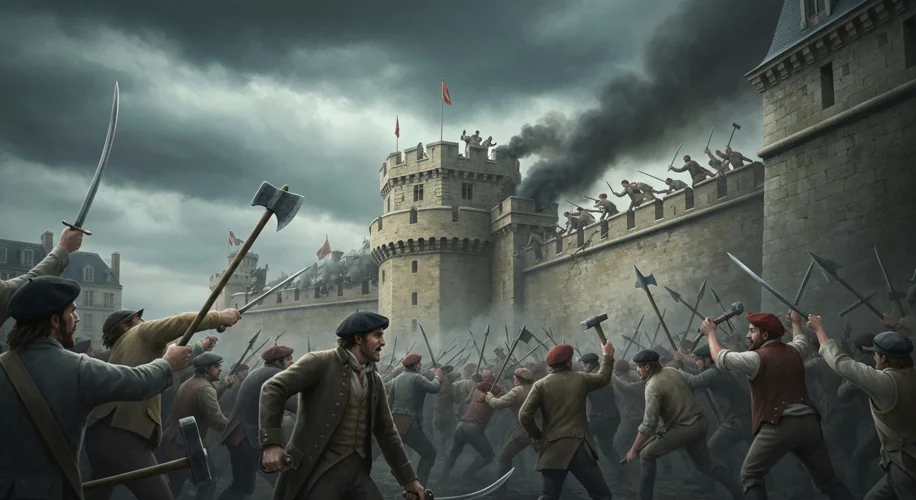The air in Paris on July 14, 1789, was thick with a volatile mix of fear, desperation, and a simmering rage that had been brewing for generations. For years, the common people of France had suffered under the weight of an archaic feudal system, crushed by exorbitant taxes while the aristocracy lived in gilded luxury. The monarchy, embodied by King Louis XVI and Queen Marie Antoinette, seemed oblivious to the suffering of their subjects, their extravagant lifestyles a stark contrast to the gnawing hunger in the streets.
The Enlightenment had spread ideas of liberty, equality, and fraternity, planting seeds of discontent that were now bearing bitter fruit. Economic hardship, exacerbated by poor harvests and the kingdom’s crippling debt from costly wars, pushed the populace to the brink. Whispers of revolution grew louder, fueled by pamphlets and fiery speeches that denounced the injustices of the Old Regime.
The immediate catalyst for the storming of the Bastille was the King’s dismissal of Jacques Necker, his finance minister, who was seen by many as a champion of the people. This act was interpreted as a clear sign that the King intended to suppress the burgeoning National Assembly and crush any hopes for reform. Panic seized Paris. Rumors spread like wildfire: the King was amassing troops to attack the city, and the nobility was arming itself to defend its privileges.
Amidst this chaos, the focus turned to the Bastille, a formidable medieval fortress in the heart of Paris, serving as a state prison. Though by 1789 it held only a handful of prisoners, its imposing stone walls and towering presence made it a potent symbol of royal tyranny and arbitrary power. The desperate Parisians, armed with whatever they could find – muskets, pikes, even scythes – marched towards the Bastille, not necessarily to free prisoners, but to seize the gunpowder and weapons rumored to be stored within.
The scene at the Bastille was one of escalating tension. A delegation from the Hôtel de Ville (City Hall) attempted to negotiate with the governor, Bernard-René de Launay, but their efforts were met with resistance and escalating gunfire. The crowd, fueled by anger and a sense of betrayal, pressed closer. The drawbridge was lowered, and a chaotic melee ensued. Accounts vary, but it is clear that shots were fired, leading to a violent confrontation. The revolutionaries, driven by a potent mix of fury and determination, eventually overwhelmed the small garrison. The governor, de Launay, was captured and tragically killed, his head paraded through the streets on a pike—a gruesome testament to the depth of the people’s rage.

The fall of the Bastille on July 14, 1789, was more than just the capture of a fortress; it was a seismic shift. It signaled to the world that the power of the monarchy was not absolute and that the people, when united by a common grievance, could challenge and overcome the established order. The event sent shockwaves across France and Europe, igniting the flames of revolution.
In the immediate aftermath, the symbolic victory at the Bastille emboldened the National Assembly, leading to the abolition of feudalism and the drafting of the Declaration of the Rights of Man and of the Citizen. The king was forced to acknowledge the new order, and the Tricolore, the new flag of France, began to fly.
The consequences of the Bastille’s fall were profound and far-reaching. It became a powerful symbol of the French Revolution, celebrated annually as Bastille Day, a national holiday in France. It marked the beginning of the end for the Bourbon monarchy and paved the way for a republic, albeit one that would endure years of turmoil, violence, and political upheaval, including the Reign of Terror.
The fall of the Bastille serves as a stark reminder of the consequences of unchecked power and the enduring human desire for liberty and justice. It demonstrated that even the most formidable symbols of oppression can crumble when faced with the collective will of a people demanding change. The echoes of that fateful day in Paris continue to resonate, inspiring movements for freedom and self-determination across the globe.

